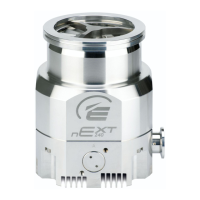B800-00-880 Issue D
Page 6 © Edwards Limited 2013. All rights reserved.
Edwards and the Edwards logo are trademarks of Edwards Limited.
Introduction
A system operating with only a parallel connection is not capable of adjusting the configuration settings stored in the
controller (for example, power limit setting or controlled venting options). In this case, all these features would be
at their factory default settings. It is possible to manually adjust the standby speed if standby mode is selected,
however, the controller should be configured separately before fitting the nEXT pump to the system. This is covered
in more detail in Section 1.5.5.
1.5.2 Serial control and monitoring
The serial communications link provides complete control and monitoring by using just three signal lines. The serial
data lines share the same connector pins as the parallel signals standby and fail. The serial data lines can be
configured to provide an RS485 compliant or RS232 compatible interface by setting the position of the RS485/RS232
slide switch (refer to Section 3.7)
The serial enable signal MUST be linked to 0 V for the system to accept commands from the serial link. This is a safety
feature and acts as an interlock. For pure serial control, the parallel start signal will be left unconnected.
The controller will still provide the normal and analogue signals on the logic interface connector even when operating
under serial control. The status of the normal signal and the value of the system parameter on the analogue output
can also be obtained by interrogating the system status via the serial link.
For more information about the serial interface, refer to Section 3.7.
1.5.3 Serial control with parallel monitoring
Since normal and analogue signals remain available even using serial control, it is possible to control the pump via
the serial link whilst monitoring these signals in the parallel interface.
The serial link uses the same connector pins as the parallel signals standby and fail so these parallel control and
monitoring signals are not available. The serial enable signal MUST be linked to 0 V and the parallel start signal will
be left unconnected.
1.5.4 Parallel control with serial monitoring or serial configuration
This method of control is best for users who normally wish to operate the pump in parallel control mode but
occasionally want to adjust the configuration settings stored in the controller or to monitor operational status of the
pump via the serial link.
The serial enable signal must be linked to 0 V for serial communications to take place. Whilst operating under parallel
control with the serial link active, the parallel start control signal is available (as described in Section 1.5.1.) but the
standby control line is not since it is used as a serial data line.
If the serial enable line is deactivated at any time whilst the RS485/RS232 slide switch is in the RS232 position, the
serial link should also be disconnected. Edwards suggests making a special cable for serial communications that
includes a link between serial enable and 0 V. This way, serial enable is automatically activated when the cable is
connected and then deactivated when the cable is removed.
1.5.5 Controller configuration (serial configuration)
All the configuration settings stored within the controller are retained even when power to the nEXT pump is
removed. This means that it is possible to use a separate system to configure the controller before fitting the nEXT
pump to the application. This gives the benefit of tailoring the pump functionality to a customer application and
allows the pump to be operated using a simple parallel interface system.
To configure the nEXT pump, either use a customer simple serial system or use the Edwards TIC Turbo Controller or
Turbo Instrument Controller. The TICs have a feature which allows storage of a nEXT pump’s configuration. The
configuration can then be downloaded to another nEXT pump. This is useful when configuring a number of nEXT
pumps with the same settings before they are fitted to a system.

